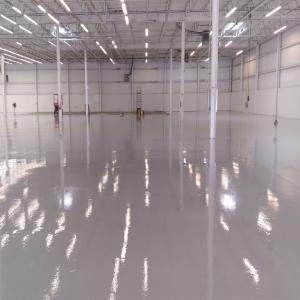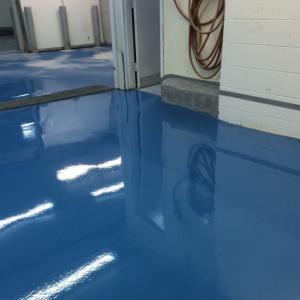New Technology Extends The Lifespan Of Resinous Flooring
Advances In Resinous Flooring
MIDDLESEX, NJ, UNITED STATES, September 12, 2025 /EINPresswire.com/ -- Epoxy flooring has long been praised for its strength, durability, and sleek appearance, making it a favorite choice for garages, warehouses, restaurants, and hospitals. However, traditional epoxy coatings have always come with one limitation: their lifespan. Depending on traffic and usage, epoxy floors often last 5–10 years before showing signs of wear.The good news? New technology is changing that. Thanks to advancements in nanotechnology, self-healing polymers, and protective topcoats, epoxy floors can now last 15–25 years or more, even in high-demand environments. This article explores the latest innovations in epoxy flooring technology and how they’re revolutionizing floor longevity.
*The Evolution of Epoxy Flooring
Since its introduction decades ago, epoxy flooring has grown from being a basic industrial coating to a high-performance solution for residential and commercial spaces. While traditional systems were strong, they lacked resistance against UV light, harsh chemicals, and constant heavy traffic.
Recent breakthroughs in material science have produced epoxy systems that not only last longer but also maintain their appearance, safety, and hygiene over time.
*Challenges That Reduce Epoxy Floor Longevity
Heavy Traffic and Mechanical Stress
Forklifts, carts, and foot traffic wear down epoxy coatings over time.
Chemical Exposure and Staining
Spills from oils, acids, and cleaning agents can cause discoloration and corrosion.
Moisture and Temperature Fluctuations
Improper installation on damp concrete can lead to peeling and bubbling.
Poor Installation and Maintenance
DIY kits and rushed curing often result in weak adhesion and shorter lifespans.
*Breakthrough Technologies in Epoxy Flooring
-Nanotechnology-Enhanced Epoxy Coatings
Nano-additives increase hardness, scratch resistance, and chemical protection, making floors last longer.
-Polyaspartic and Urethane Topcoats
These advanced topcoats provide UV stability, faster curing, and flexibility, preventing cracks and yellowing.
-Self-Healing Epoxy Systems
Cutting-edge polymers allow floors to repair micro-cracks automatically, extending their service life.
-UV-Resistant and Anti-Yellowing Additives
Traditional epoxy tends to yellow over time under sunlight. New additives keep floors looking clear and glossy.
-Slip-Resistant and Anti-Microbial Innovations
Embedded quartz, aluminum oxide, and antimicrobial coatings improve safety and hygiene, especially in kitchens and hospitals.
*Benefits of New Technology for Epoxy Flooring
-Increased Durability and Scratch Resistance
Floors withstand heavier loads and sharper impacts without damage.
-Improved Chemical and Heat Resistance
Modern epoxies resist acids, oils, grease, and high temperatures.
-Longer Aesthetic Lifespan
Floors maintain their shine, color, and clarity much longer.
-Lower Maintenance Requirements
With advanced coatings, less frequent repairs and recoats are needed.
*Comparing Standard Epoxy vs. Advanced Epoxy Systems
Feature Standard Epoxy Advanced Epoxy Technology
Lifespan 5–10 years 15–25+ years
Resistance to UV Poor (yellows over time) Excellent (UV stable)
Resistance to Chemicals Moderate High
Maintenance Higher Lower
Cost Lower upfront, Higher upfront, better ROI
*Cost Analysis: Is New Technology Worth It?
-Upfront Investment vs. Long-Term Savings
Advanced epoxy systems may cost $8–15 per square foot, compared to $4–6 for standard epoxy.
-Return on Investment for Businesses
For facilities that rely on hygiene, durability, and safety, the extended lifespan provides significant cost savings and reduces downtime.
*Urethane Concrete Flooring for Commercial Kitchens and Its Origins
In the demanding environment of a commercial kitchen, flooring isn’t just about aesthetics—it’s about safety, hygiene, and long-term performance. From hot oil spills to constant moisture, floors must withstand extreme stress daily. One flooring solution has consistently proven its value: urethane concrete flooring.
But where did it come from, and why has it become the go-to flooring option for food service facilities worldwide?
*What Is Urethane Concrete Flooring?
Urethane concrete (also known as urethane cement) is a hybrid flooring system made by blending urethane resin with cement and aggregate. The result is a dense, seamless, and highly durable floor that bonds tightly to concrete substrates.
Key Characteristics and Properties
Withstands extreme temperature changes
Non-porous and resistant to bacterial growth
Chemically resistant to acids, oils, and cleaning agents
Slip-resistant for enhanced worker safety
*How It Differs from Epoxy and Other Flooring Options
While epoxy flooring is durable, it struggles with thermal shock and prolonged heat exposure. Urethane concrete, on the other hand, was engineered to handle boiling water, hot oil, and steam cleaning without cracking or delaminating.
*
-The Origins of Urethane Concrete Flooring
Early Development in Industrial Settings
Urethane concrete flooring originated in the mid-20th century as industries sought materials that could endure harsh chemical exposure and heavy machinery.
-Transition to Food Processing and Commercial Kitchens
Food and beverage manufacturers were among the first to adopt urethane concrete, recognizing its ability to withstand thermal cycling and rigorous sanitation practices.
-Global Adoption and Industry Standards
Over time, urethane concrete became a gold standard for commercial kitchens worldwide, meeting FDA, USDA, and HACCP compliance requirements.
*The Future of Epoxy Flooring Longevity
Thanks to new technology, epoxy flooring is no longer just a 5–10 year solution. With nanotechnology, self-healing polymers, and UV-resistant coatings, epoxy floors can now last two decades or more while staying beautiful and durable.
Whether in industrial warehouses, commercial kitchens, hospitals, or homes, these advancements make epoxy flooring one of the most cost-effective and long-lasting flooring solutions available today.
Jeffrey Smedley
High Performance Systems
+ +1 800-928-7220
jsmedley@hpsflooring.com
Visit us on social media:
LinkedIn
Instagram
Facebook
YouTube
X
Legal Disclaimer:
EIN Presswire provides this news content "as is" without warranty of any kind. We do not accept any responsibility or liability for the accuracy, content, images, videos, licenses, completeness, legality, or reliability of the information contained in this article. If you have any complaints or copyright issues related to this article, kindly contact the author above.


